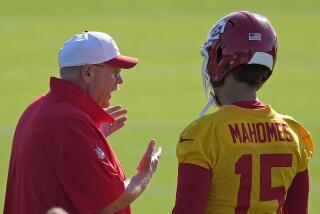NFL UPDATE : League, Players’ Union Can’t Agree on a Plan : DRUGS
- Share via
It has been nearly seven months since Don Rogers died of a cocaine overdose, and yet the National Football League apparently is no closer to an effective, acceptable program aimed at preventing drug abuse than it was then.
It’s not for lack of trying, though. Seemingly, the only agreement is that the league needs some type of plan.
As it stands, the players are tested in training camp in July, then can be tested during the season if there has been probable cause.
The NFL Players Assn. proposed a plan in March calling for spot-check urinalyses of players in certain circumstances, financial penalties for repeat offenders and lifetime suspension for three-time offenders.
That plan was vetoed by NFL Commissioner Pete Rozelle, who was in the process of putting together his own program.
Barely two weeks after Rogers, a starting safety for the Cleveland Browns, died in Sacramento on June 27, the day before he was to be married, Rozelle announced his plan.
It called for two unscheduled tests for all players during the season, besides testing at training camp. Players testing positive for drugs three times would have been banned for at least a year.
Gene Upshaw, NFLPA executive director and a former all-pro guard for the Raiders, protested immediately, claiming that under the terms of the NFL’s collective bargaining agreement, the commissioner could not unilaterally impose his plan on the players.
The NFLPA went to court in an attempt to block the plan, and eventually both sides agreed to binding arbitration. Arbitrator Richard Kasher of Philadelphia ruled in favor of the union.
And that’s where it stands today. The league wants a drug plan and so does the union, but the stumbling block is random testing. Whenever the players vote on it, the tally is 80%-90% against.
“Obviously, the program we have now needs strengthening,” Upshaw said. “We’ll address it during the coming off-season. We need to impose stronger penalties, we need more education and we need confidentiality.
“We’re opposed to random drug testing. We believe a person is innocent until proven guilty. They want to test whenever they feel like it. We’re opposed to that.
“We don’t want a guy to be tested just because he falls asleep in a meeting, or looks like he’s tired, or misses a block. We don’t want a team to be able to test its players just because they’re losing.”
The league’s position? Said Jack Donlan, executive director of the NFL Management Council: “All the doctors we have dealt with have been very strong in their belief that unscheduled testing is a needed part of any drug program.
“There has been very little success in curing drug addicts, so our rationale is this: Addicts come from yesterday’s recreational user category. A recreational user can start or stop. The only way to stop the problem is to get at the recreational user.
” If tests are scheduled beforehand and are not a surprise, then the recreational user will simply stop until they’re tested, then return afterward.”
In 1983, Rozelle was quoted as saying that drug use in the NFL was “way below 50%, way below 20% (of the players), on the basis of our security reports.”
No one knows that for sure, though, because there is no accurate data. All the public knows about are the cases that make the headlines.
Six New England Patriots were reported as drug users in the days immediately following their 46-10 drubbing at the hands of the Chicago Bears in the Super Bowl last season.
At least two players who have undergone drug rehabilitation will play in the Super Bowl next Sunday in Pasadena. Linebacker Lawrence Taylor of the New York Giants, voted most valuable player in the NFL last week, underwent treatment after the 1985 season. Tight end Clarence Kay of the Denver Broncos returned to the team just recently after treatment for his drug problem that surfaced at mid-season.
Only once has the NFL banished a player the way the National Basketball Assn. did last week with guards Lewis Lloyd and Mitchell Wiggins of the Houston Rockets. In 1973, Rozelle suspended Lance Rentzel of the Rams for a season after he was convicted of marijuana possession, a misdemeanor in California.
Rozelle also suspended Pete Johnson and Ross Browner of the Cincinnati Bengals, E.J. Junior of the St. Louis Cardinals and Greg Stemrick of the New Orleans Saints for the first four games of the 1983 season because of their drug use.
Last year, defensive end Mike Bell of the Kansas City Chiefs and his brother Mark, a former NFL player, were sentenced to prison for drug trafficking.
Other NFL players have done time for dealing in drugs, starting with Don Reese and Randy Crowder of the Miami Dolphins in 1977, and including the cases of Eugene (Mercury) Morris and Thomas (Hollywood) Henderson.
Tailback Barry Word of Virginia was a third-round draft choice of the New Orleans Saints last year, but he never got to training camp after he was accused of cocaine distribution.
Sources say Word was one of 55 college seniors who tested positive for drug use at a tryout camp held by NFL teams last year. On draft day, 26 of them were chosen anyway.
Additionally, there have been countless pro careers shortened by drug use. Included were such stars and projected stars as Chuck Muncie, Joe Gilliam, Tony Peters, Rick Upchurch, Leroy Harris, Vernon Perry, Clarence Harmon, Rickey Young, John Reaves and Willie T. Spencer.
Steroids, artificial hormones that produce bulk and muscle but also produce many serious side effects, are another problem, one that has been basically unexplored by the NFL.
In December of 1983, Rozelle sent a letter to all 28 NFL teams, warning players that the use of nonmedical steroids could result in disciplinary action. To date, no NFL players have been penalized for steroid use.
In a recent television interview, Howie Long of the Raiders said the NFL’s biggest drug problem could be with the use of steroids. He said that many injuries were the result of strain on 250-pound bodies that had been artificially pumped up to 280.
“The focus seems to be going toward steroids,” Upshaw said. “We can blame society for drugs, but I guess steroids are an institutional problem.”
More to Read
Go beyond the scoreboard
Get the latest on L.A.'s teams in the daily Sports Report newsletter.
You may occasionally receive promotional content from the Los Angeles Times.










